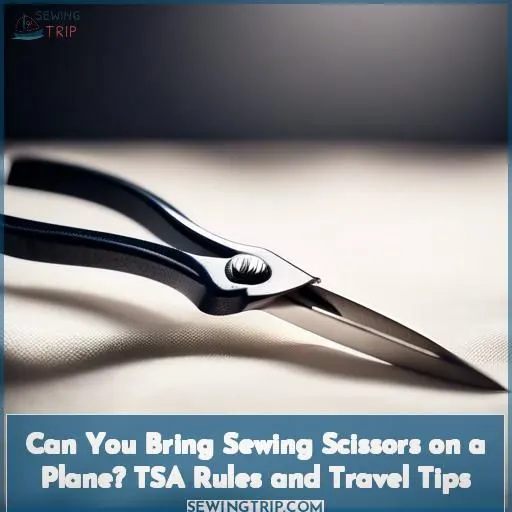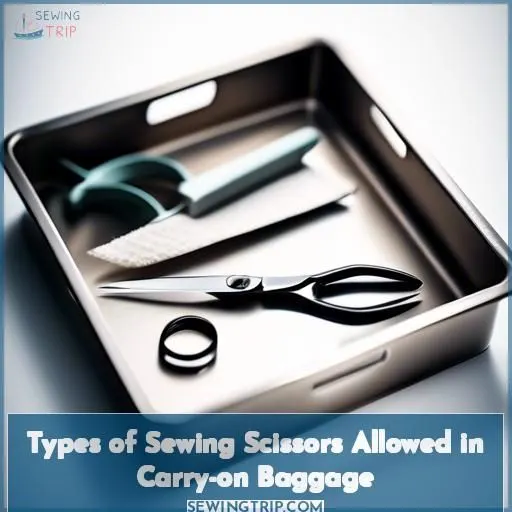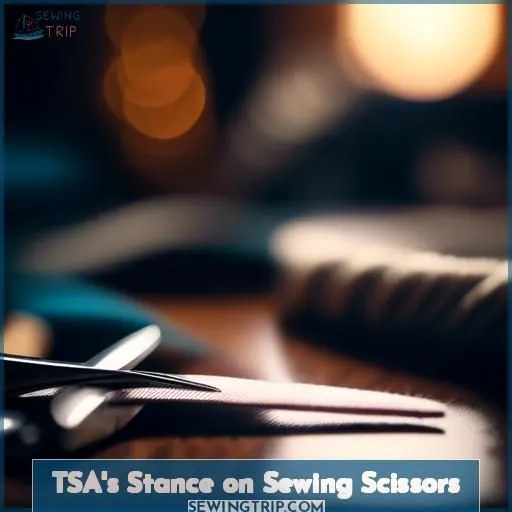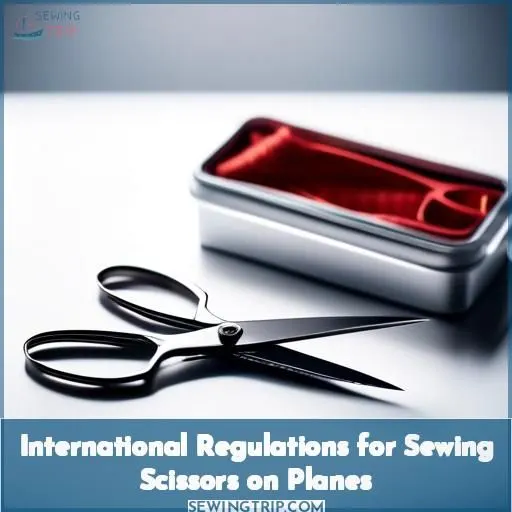This site is supported by our readers. We may earn a commission, at no cost to you, if you purchase through links.
Yes, you can bring sewing scissors on a plane, but they must adhere to TSA regulations.
Scissors with blades 4 inches or less from the pivot point are generally permitted in carry-on baggage.
This includes small, round-tipped scissors like embroidery scissors and miniature scissors under 2 inches.
However, thread cutters are not allowed.
Securely store your sewing needles to avoid pricks during screening.
Place scissors and needles in a clear bag, treating them like liquids.
Want to guarantee a smooth journey? Continue on for more tips about carrying sewing scissors when flying.
Table Of Contents
- Key Takeaways
- Can You Bring Sewing Scissors on a Plane?
- Can You Bring Sewing Scissors on a Plane?
- Types of Sewing Scissors Allowed in Carry-on Baggage
- TSA’s Stance on Sewing Scissors
- International Regulations for Sewing Scissors on Planes
- Tips for Traveling With Sewing Scissors on a Plane
- Frequently Asked Questions (FAQs)
- Conclusion
Key Takeaways
- TSA regulations allow scissors with blades under 4 inches from the pivot point in carry-on baggage.
- Sewing needles are also allowed, but they should be stored securely to avoid accidental pricks.
- International regulations vary, so it’s essential to research the specific rules of the country you’re visiting.
- Some airlines have specific guidelines, so it’s important to verify with your carrier before traveling.
Can You Bring Sewing Scissors on a Plane?
Yes, you can bring sewing scissors on a plane as long as they are smaller than 4 inches from the pivot point.
Can You Bring Sewing Scissors on a Plane?
You can bring sewing scissors on a plane, but there are certain rules and restrictions to adhere to. According to the TSA, scissors with blades no longer than 4 inches from the pivot point are permitted in carry-on baggage. However, if your scissors are longer than 4 inches, they must be placed in checked baggage. International regulations also differ, with some countries permitting scissors with blades up to 6 cm.
When packing your sewing scissors, it’s imperative to follow the guidelines to avoid potential confiscation. TSA agents have the final decision, so it’s advisable to travel with less expensive notions in case of confiscation. If you’re traveling with cross stitch supplies, you can bring small scissors with blades no longer than 6 cm in your hand luggage.
In addition to scissors, you can also bring sewing needles, knitting needles, and crochet hooks in your carry-on baggage. Nail clippers can also be used to cut threads. However, circular thread cutters and other tools with blades must be placed in checked baggage.
When traveling with sewing scissors, it’s vital to keep them securely packed to prevent unintentional pricks and comply with airport security regulations. Be prepared to clarify the purpose of your scissors if asked, and consider traveling with less expensive notions in case of confiscation.
Types of Sewing Scissors Allowed in Carry-on Baggage
When traveling with sewing scissors, it’s essential to be aware of the specific types accepted in carry-on baggage. According to TSA regulations, scissors with blades under 4 inches from the pivot point are permitted in carry-on luggage. This implies that small, round-tipped scissors, such as embroidery scissors, are typically allowed. However, larger scissors, like rotary cutters or circular thread cutters, must be packed in checked baggage.
For cross stitchers, miniature scissors (under 2 inches) are recommended for travel, as they’re easier to handle and typically meet the size requirements for carry-on luggage. It’s also vital to note that thread cutters aren’t allowed in carry-on baggage, and scissors and needles should be placed in a transparent bag and treated like liquids.
When packing your project, consider using a small project bag, a thread box or mini thread box, sheathed scissors, needles in a transparent container, and a printed copy of your pattern. It’s also suggested to use shorter lengths of thread and pre-sort and cut threads to length before your flight.
Remember to verify with your airline before traveling, as international regulations may vary. For instance, in Australia, blades under 6cm are allowed, while in New Zealand, scissors no longer than 6cm are permitted. In the European Union, scissors no longer than 6cm are allowed, but Air France specifically prohibits needles and scissors.
TSA’s Stance on Sewing Scissors
Regarding packing sewing scissors for a flight, the TSA’s position is unambiguous. Here’s what you require to cognizant:
- Blade Length: Scissors with blades less than 4 inches are generally permissible in carry-on baggage.
- Needle Storage: Sewing needles are also allowed, but they should be stored securely to obviate accidental pricks.
- Security Screening: At security checkpoints, sewing scissors and needles should be placed in a clear bag and treated like liquids.
- International Travel: Regulations vary by country and airline, so be sure to investigate the stipulations of both your departure and destination.
- Airline Regulations: Some airlines have specific guidelines, so it’s imperative to verify with your carrier before traveling.
International Regulations for Sewing Scissors on Planes
When traveling internationally, it’s essential to be aware of the varying regulations for sewing scissors. While the TSA guidelines in the United States permit scissors with blades no longer than 4 inches in a carry-on bag, other countries may have different restrictions. For instance, Australia allows blades under 6cm, New Zealand permits scissors no longer than 6cm, and Hong Kong allows blades under 6cm as measured from the fulcrum. However, some countries may prohibit all scissors, such as Air France.
Airline policies can also vary. For example, Virgin Australia allows scissors with blades under 6cm, while Air New Zealand prohibits all scissors. It’s essential to verify the specific rules of the country you’re visiting and guarantee your scissors comply with their regulations. Remember, international flights don’t always agree on what’s allowed, so it’s essential to research both the departing and destination countries before your trip.
In addition to understanding country-specific regulations, it’s also important to take into account the potential security threat posed by scissors. While small scissors are generally allowed in carry-on luggage, larger or heavy-duty scissors are typically prohibited and should be packed in checked baggage. To guarantee a smooth airport security experience, it’s recommended to check the latest guidelines provided by the Transportation Security Administration (TSA) or the relevant airport or aviation authority in your destination country.
Tips for Traveling With Sewing Scissors on a Plane
- Packing Strategy: Store your sheathed scissors in a clear plastic bag and treat them like liquids during TSA screening.
- Alternative Tools: Consider using micro scissors (under 2 inches) or embroidery scissors (rounded and no larger than 4 inches total) for travel.
- Airport Amenities: Many airports offer mail services, so bring a padded envelope and stamps to mail back disallowed items.
- Travel Etiquette: Be polite when stopped by TSA agents and keep potentially flagged items in plain sight.
Frequently Asked Questions (FAQs)
Are there any restrictions on carrying scissors with blades longer than 4 inches in carry-on baggage?
You can’t carry scissors with blades exceeding 4 inches in your carry-on luggage. The TSA considers longer blades a potential safety risk, so they’ve to be packed in checked baggage instead. Safety first when flying!
Can you bring scissors with rounded tips in carry-on baggage?
Absolutely! You can carry small scissors with rounded tips no longer than 4 inches in your carry-on bag. Just be sure to place them in a clear, ziplock bag for easy screening. The TSA knows crafters need their trusty snips on the go.
Are there any specific airline regulations for carrying scissors in checked baggage?
In the realm of checked baggage, airlines typically exhibit a slightly more lenient stance regarding scissors. However, it’s prudent to engage in a telephonic conversation with the airline to obtain the most accurate information. After all, prioritizing safety should remain paramount, don’t you agree?
Can you bring needlepoint tools with blades in carry-on baggage?
You’ll need to leave those needlepoint tools behind, my friend. Anything with blades isn’t allowed through security – unless you want a stern talking-to (or worse)! Stow them safely in your checked bag, and stick to harmless needles for your carry-on.
Are there any alternatives to scissors for sewing on a plane?
You bet! Consider a small thread nipper or portable thread cutter. They make quick work of snipping thread without raising eyebrows. Just tuck it away neatly in your project bag, and you’re good to go – safe travels!
Conclusion
Ultimately, bringing sewing scissors on a plane requires adhering to TSA regulations.
If you’re traveling with scissors under 4 inches from the pivot point, you can carry them on board.
Just remember to store them properly in a clear bag, separate from other items.
By following these guidelines for bringing sewing scissors on a plane, you’ll guarantee a hassle-free experience and arrive at your destination ready to sew.











